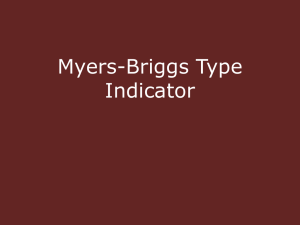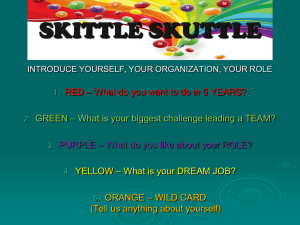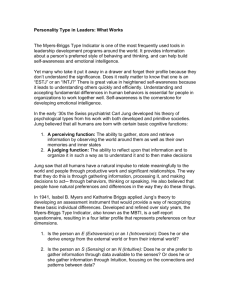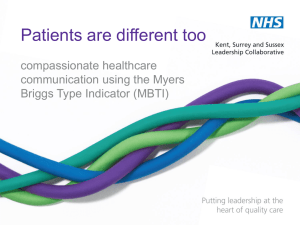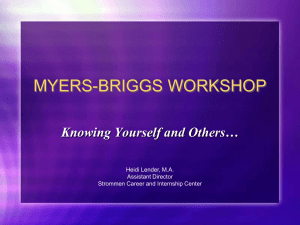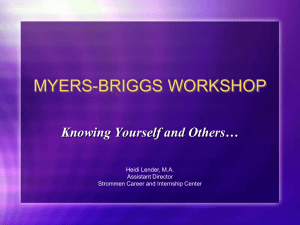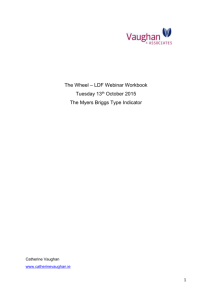The Four Keirsey Temperaments and Their Variants
advertisement
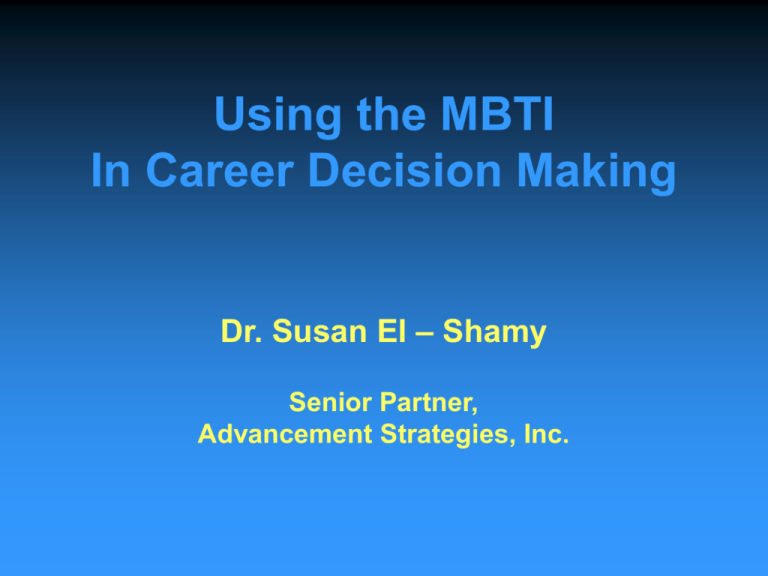
Using the MBTI In Career Decision Making Dr. Susan El – Shamy Senior Partner, Advancement Strategies, Inc. Purpose: to gain a basic understanding of the MBTI and how it can be used in career decision making Objectives: 1. review the 8 preferences and 16 types 2. consider your own MBTI scores and what they can tell you about yourself 3. Consider the implications of the MBTI for career development Some Things About the MBTI Origins: • Based on Jung’s theory of perception and judgment. • In existence for over 40 years. • Used world-wide with hundreds of thousands of people. • One of the most valid, reliable assessments in existence. • Basis for a vast amount of research and theory. Scores: • No good or bad scores. • Type tends to remain constant throughout life. • Split scores, or scores that are nearly the same, may vary on different takings of the assessment, but there is usually one that is slightly preferred over the other. To make the most of your MBTI results, it is important to understand that the MBTI: • Describes rather than prescribes • Describes preferences, not skills or abilities • Says that all preferences are equally important • Is well documented and researched Because the results on the MBTI are subject to a variety of influences, they need to be treated with skepticism and individually verified. Each individual needs to determine the type which best describes him or her. This may or may not be the same type as reported on the MBTI. Four Scales and Eight Preferences What is a preference? “When you use your preferred side on any of the four type dimensions—like using your preferred hand – you are doing what comes naturally. And when you are required to use the opposite side, it takes a lot of extra work and you’re not as good at it; hence, the experience is usually not as satisfying.” The 4 scales and 8 preferences on the MBTI are as follows: 1 – How You Prefer to Focus Your Attention (E) Extraversion (I) Introversion 2 – How You Prefer to Acquire Information (S) Sensing (N) Intuition 3 - How You Prefer to Make Decisions (T) Thinking (F) Feeling 4 - How You Prefer to Live Your Life (J) Judging (P) Perceiving Everyone has all eight preferences. However, some preferences are stronger than others. Some are much stronger. As we review the eight preferences, consider which sound like you and which don’t. Suggestion: Put away your assessment and as we go through each of the eight preferences, consider what sounds like you and what doesn’t. Then, guess your four-letter type. Then, see how closely it matches your result. Extraversion & Introversion • People who prefer Extraversion tend to focus on the outer world of people and things. When you are extraverting, you are energized by what goes on in the outer world, and this is where you tend to direct your own energy. Extraverts usually prefer to communicate more by talking than by writing. They need to experience the world in order to understand it and thus tend to like action and variety. • People who prefer Introversion focus more on their inner world. When you are introverting, you are energized by what goes on in your inner world, and this is where you tend to direct your own energy. Introverts tend to be more interested and comfortable when they can work quietly without interruption. They like to understand the world before experiencing it, and also need time to reflect before acting. Extraversion and Introversion Extraverts tend to: Introverts tend to: • think out loud • become easily • • • • • • • • energetic be animated and energetic act first and think about it later enjoy generating ideas with a group be very comfortable in social settings seek out social situations and settings find listening more difficult than talking • • • • • • focus their energy inwardly need time alone to recharge be less animated, more reserved have a calm, measured demeanor think first and maybe speak later become easily absorbed in thought talk slower and usually more quietly proceed cautiously in meeting people Sensing and Intuition • Sensors focus on the realities of a situation. People who are Sensors prefer to take in information through their senses; they want to see it, hear it, feel it. Sensing types tend to accept and work with what is “given” in the here-and-now, and thus become realistic and practical. They are good at remembering and working with a great number of facts. They prefer to use proven procedures and are careful with detail. • Intuitives prefer taking in information through a “sixth sense” and noticing what might be. Intuition shows you the meanings, relationships, possibilities that go beyond the information from your senses. Intuitive types look at the big picture and try to grasp the overall patterns. They grow expert at seeing new possibilities and they value imagination and inspiration. Sensing and Intuition Sensors tend to: Intuitives tend to: • be quite literal • be direct and to the point • listen until others have • envision the future • leap from thought to • • • • • finished prefer precise and exact information enjoy traditional and familiar ground value solid, recognizable achievements use clear, straightforward speech patterns prefer a sequential, stepby-step approach • • • • • • thought have complex speech patterns finish other people’s sentences use language to express themselves focus on possibilities, what might be value different and unusual attainments talk about global issues, the “big picture” Thinking and Feeling • Thinkers make decisions objectively, on the basis of cause and effect, by analyzing and weighing the evidence. They focus on the logical consequences of any choice or action. Thinking types seek an objective standard of truth; they are good at analyzing what is wrong with something. • Feelers make decisions based on person-centered values. When deciding, they consider how important the choices are to themselves and others. They like dealing with people and tend to be sympathetic, appreciative, and tactful. They value harmony and work to make it happen. Thinking and Feeling Thinkers tend to: Feelers tend to: • get right to the point • often appear • decide with the heart • engage in social niceties • get their feelings hurt • • • • • businesslike are usually very assertive choose truthfulness over tactfulness give praise sparingly; point out negatives convince others with impersonal reasoning make decisions with their heads, not hearts • • • • • easily avoid arguments and conflict be sensitive to the feelings of others act warm and friendly toward others pay attention to the feelings of others be generous with praise; slow to criticize Judging and Perceiving • Those who prefer • Those who prefer judging like to live in a perceiving like to planned, orderly way, wanting to regulate life and control it. They want to make decisions, come to closure, and then carry on. They like to be structured and organized and want thing settled. live in a flexible, spontaneous way, gathering information and keeping options open. They seek to understand life rather than control it. They prefer to stay open to experience, enjoying and trusting their ability to adapt to the moment. Judging and Perceiving Judgers tend to • Make decisions; decide • • • • • • • quickly Enjoy setting and reaching goals Discuss schedules and timetables Like to take charge and be in control Be more serious, formal, conventional Postpone play until all the work is done Regulate and control their life and yours Enjoy having things settled, taken care of Perceivers tend to: • Be good at adapting • Be somewhat • • • • • • disorganized Deal with issues as they arise Procrastinate, put off decisions Be more playful, casual, unconventional Keep their lives as flexible as possible Find rules and structure confining, limiting Desire many experiences and miss nothing There are 16 possibilities. Look at your notes, think about the information you have just received and guess your four-letter type. ISTJ ISFJ INFJ INTJ ISTP ISFP INFP INTP ESTP ESFP ENFP ENTP ESTJ ESFJ ENFJ ENTJ What did you guess your type to be? Now, look and see what your assessment results were. If you don’t like your results, change them. You know you better than anyone. Now, get a partner. Turn and talk to your neighbor, or someone next to you, behind you, in front of you, whatever. Take a few minutes and discuss your results. What do you agree with? What do you disagree with? Questions? Comments? Concerns? Theories About Type Keirsey’s 4 Temperaments: SP - “the artist” - troubleshooter SJ - “the technician” - stabilizer NT - “the scientist” - architect, designer NF - “the theologian” - catalyst, motivator Myers-Briggs’ 4 Styles: IS - the Thoughtful Realist ES - the Action-Oriented Realist IN - the Thoughtful Innovator EN - the Action-Oriented Innovator Do people go into certain professions or occupations according to their “type”? What “types” would choose business as a major in college? Within business, what “types” would choose accounting as a major? What “types” would major in personnel, human resources, and training? Distribution of Types within Occupational and Academic Groups Occupations ST (%) SF (%) NF (%) NT (%) Accountants 64 23 4 9 Bank employees 47 24 11 18 Sales, customer relations 11 81 8 0 Creative writers 12 0 65 23 Research scientists 0 0 23 77 ST (%) SF (%) NF (%) NT (%) Finance, Business 51 21 10 18 Nursing 15 44 34 7 Counseling 6 9 76 9 Science 12 5 26 57 Health related 13 36 44 7 Education 13 42 39 20 Journalism 15 23 42 20 Phys. Ed. 32 34 24 10 Engineering 24 11 22 43 Fields of College Studies MBTI – 3990 Students from Jan. 1994 through Jan. 1998 SJ = 1762 SJ = 44% SP = 820 SP = 21% NF = 554 NF = 14% NT = 854 NT = 21% A Few Guidelines for Using Type Wisely • Type is about preferences; people can still make • • • • choices about behavior. Some tasks will be more natural for some types than others, but all types can learn skills in their nonpreferred areas. Doing things in nonpreferred areas will likely take more energy, but these tasks do become easier with practice. Type is most useful when we use it to understand ourselves and our impact on others, to maximize our strengths, and to minimize our weaknesses. A genuine belief in the mutual usefulness of all type preferences is central to the wise use of a type perspective. Using your MBTI information to help in your career decision making. What’s the most important thing that you will be looking for in a job? Find a job where your natural preferences will be an asset. Doing what you enjoy doing, what you naturally do very well, will give you the extra edge to top performance! Type in the Workplace* Extraversion Like variety and activity Like having people around Often impatient with long, slow jobs Act quickly sometimes without thinking Develop ideas by discussion Introversion Like quiet and calm Like working alone Don’t mind long work on one project Think before acting, may not act Sensing Like standard ways of problem solving Enjoy applying what they already know May distrust and ignore inspirations Like to do practical things Like to present details first Proceed step-by-step Intuition Like solving new, complex problems Develop ideas by reflection Enjoy learning something new May follow inspirations, good or bad Like to do innovative things Like to present overview first Proceed in bursts of energy Thinking Use logical analysis to decide May unknowingly hurt feelings Firm-minded, can give criticism Look at the principles involved Feel rewarded when job is done Judging Work best following a plan Like to get things settled, finished May not notice new things to do Reach closure by deciding quickly Seek structure and schedules Feeling Use values and harmony to decide Enjoy pleasing people Empathetic, avoid the unpleasant Look at the values involved Feel rewarded when people’s needs met Perceiving Enjoy flexibility in their work Leave things open to possible changes May postpone unpleasant tasks Postpone decisions and look for options Feel restricted without change Questions? Comments? Concerns?
